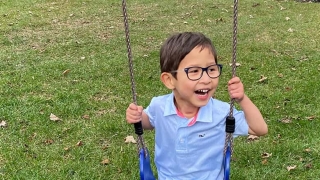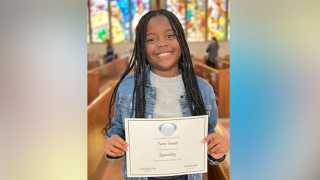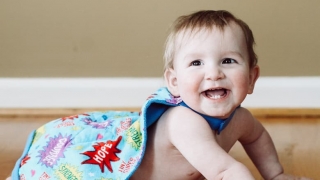Children's Hospital of Philadelphia cares for more babies born with congenital diaphragmatic hernia than any hospital in the world. This video follows Laura, Nick and their daughter, Lillian Jane, on their journey from prenatal diagnosis of CDH, care at the Richard D. Wood Jr. Center for Fetal Diagnosis and Treatment — including pregnancy management, CDH labor and delivery, and postnatal surgery — to discharge home. In this video:
- What is congenital diaphragmatic hernia? 2:09
- Evaluation, diagnosis and delivery planning for CDH baby 2:43
- CDH care requires an experienced, multidisciplinary team 4:50
- Delivery and immediate stabilization after birth 5:30
- Experience with ECMO 7:11
- Getting strong enough for surgery 7:40
- How do you fix CDH? Surgical repair of the diaphragm 9:27
- Recovery in the NICU and discharge home 10:35
- Commitment to helping families 11:30
Transcript
Congenital Diaphragmatic Hernia Repair: Lillian Jane’s CDH Story, Prenatal Diagnosis to Home
Laura, Mom: I can feel her going.
Juliana Sanchez Gebb, MD: Where’s home for you guys?
Laura: The Scranton area. About two and a half hours away.
Juliana Sanchez Gebb, MD: Yeah.
Laura: Although, this morning it was more like three.
Juliana Sanchez Gebb, MD: Lot of traffic, huh?
Nick, Dad: Is that an overhead shot? Are we looking down?
Juliana Sanchez Gebb, MD: This is actually a cross section made at the level of the heart of the baby, the chest.
Does the baby have a name?
Nick: It does.
Juliana Sanchez Gebb, MD: Is it a secret? It’s fine if it’s a secret, don’t worry, yeah. Because you know what? All you get is comments on it.
Laura: It’s not necessarily …
Nick: Lillian Jane.
Juliana Sanchez Gebb, MD: Oh, it’s beautiful.
Laura: I’m 27 weeks along. We’re expecting a little girl, and I’m hoping for the healthiest baby we can have. I know we’ve come to the right place, and I’m just very optimistic of what lies ahead.
She has a congenital diaphragmatic hernia, and when you look online, it says the worst. When we came here, it was a breath of fresh air that we might be able to take her home one day. We might be able to put her into school, and have a future for her.
There’s nothing we can’t face. She’s gonna be our daughter regardless and we’ll treat her like any other daughter we would have had, healthy or with - with some struggles.
Holly Hedrick, MD: Congenital diaphragmatic hernia -- or CDH for short -- is a defect, it’s a congenital birth defect. It happens - the problem happens around 11 weeks when the diaphragm fails to form completely. The result of that is that the things that are in the abdomen, mainly the intestines, the stomach, the liver, spleen, they can go up into the chest. And when that happens, it affects the lung growth so, it’s not so much just the hole in the diaphragm, it’s really about the effects on the cardiopulmonary system.
Julie Moldenhauer, MD: I first met Laura and Nick at the time of their initial consultation here at CHOP. They were worried about their unborn daughter, they have a small son at home, it's very overwhelming to hear all the news that your baby’s gonna spend time in an intensive care unit, and that you’re probably going to be relocated to Philadelphia for sometime during that care while you’re trying to figure out care for your child at home. And worry about your sick daughter in the NICU, and figure out, as a couple and as a family how you’re gonna manage all this.
You just wish you could provide them that clarity that day, and that’s really what our goal is, is to give them hope for what things can look like down the road.
Jessica Hertzog, MSW: How are you, dealing with the diagnosis and everything? How is that for you guys?
Nick: As good as we can. Take it day by day. I mean it is what it is. Nothing that could have been controlled or …
Jessica Hertzog, MSW: Right, yeah, it’s no body’s fault.
Nick: Nothing that we could have done. It’s a waiting game.
Laura: Right. I feel like the calm before the storm.
Jessica Hertzog, MSW: So, a lot of people say the anxiety and stress is really high at the time of diagnosis, and then, it sort of comes down during this period, or you’re making a plan, and sort of chugging along, but as you get closer to the end, it kind of goes back up.
Nick: The longer we spend here, the more confident we get in knowing that, you know we’re in good hands, you know what I mean yeah.
Laura: Yeah.
Juliana Sanchez Gebb, MD: Having a baby with a congenital diaphragmatic hernia that’s been diagnosed in utero is very stressful for families.
I'm Juliana Gebb, one of the other MFNs. Nice to meet you.
Laura: Hi, nice to meet you.
Juliana Sanchez Gebb, MD: So, I can’t control that.
Karen Pesta, MSN: We’re still going to meet you. There’s no reason to think that your delivery is gonna be anything other than normal.
Laura: Okay.
Jessica Hertzog, MSW: And I think that you hear it’s really important because they know that they’re going to get the best care possible.
Juliana Sanchez Gebb, MD: I think that maybe we can relocate you as a family.
Laura: Possibly; I mean we would - whatever is needed, we would make do.
Juliana Sanchez Gebb, MD: Because this is a condition where it is important to be close by and to be able to get here for delivery.
Laura: Right.
Juliana Sanchez Gebb, MD: So, I would think that maybe by 35, 36 weeks, it would be important to be here.
Laura: Okay.
Julie Moldenhauer, MD: A congenital diaphragmatic hernia is a very difficult diagnosis to receive as a parent.
Juliana Sanchez Gebb, MD: I’m happy with the way everything; the growth is perfect.
Laura: Okay.
Julie Moldenhauer, MD: This is the situation where it really does take a village. It takes everybody involved to make this go smoothly and for the baby to survive and do well. Babies with CDH clearly do much better when they’re born in a hospital where all the expertise is available to take care of them from the second that they arrive. And so, if we could make a plan throughout the whole pregnancy for the delivery, for mom, for baby, we can have the best outcome possible for both.
Natalie Rintoul, MD: What we find with babies who have congenital diaphragmatic hernia who have some portion of their bowel or their liver, their stomach up in their chest is that when they’re delivered, they have difficulty breathing. So, that really is one of the biggest challenges when we meet a baby in the delivery room; it’s just trying to help them breathe.
Laura: The first big hurdle is delivery and birth, and stabilizing her. And then, after a few days, depending on how her progress is, the next step will be the surgery.
Doctor: Eight, nine, ten, oh, she’s right there.
Doctor: Look at her. She’s so cute.
Nick: Her name is Lillian Jane Harding. She was seven pounds, seven ounces, born at 2:31 p.m., 2:21 p.m.
Laura: 2:21.
Nick: 2:21 p.m. and yeah, she’s doing better than expected. She is -
Laura: She looks just like our son.
Nick: Yeah. Thanks to – we’ll have to do a side by side photo later.
Laura: Uh huh, lots of hair.
Nick: Uh huh.
Natalie Rintoul, MD: For our babies with congenital diaphragmatic hernia, by the time of birth, we have the mom deliver in one room, and we have the adjoining room full of a team ready to meet the baby, and take care of them right from the very beginning.
And so, we have neonatologists, fellows, nurses, respiratory therapists, the pediatric surgeon, and everybody is available for the delivery.
Our ECMO program at the Children’s Hospital of Philadelphia is one of the busiest in the country. So we do over 50 to 60 ECMO cases a year which is really important; experience and volume matter with ECMO.
Nick: The tear in the diaphragm where the intestines are pushing up into the lungs, and pushing the heart over, and, you know after she’s born you have to have the surgery; repair the diaphragm, and then, put everything back where it should go. I think unrepaired; I think it would have been - she wouldn’t have lived.
Laura: She wouldn’t survive without the surgery.
Laura Palmer MDiv, Chaplain: Lillian we’re going to say a prayer for you and ask God’s blessing upon you this morning. I’ll begin by reading Psalm 1:21 which is a prayer of hope. I lift up my eyes to the hills from whence cometh my help. My help comes from the Lord, the Maker of heaven and earth. He will not let your foot be moved and -
Nick: It’s been a roller coaster ride. Right now she’s, the next few hours she’ll be going into surgery to fix the hernia.
Laura: There’s really no words to describe just a - you just want to be in there and hold her and everything so, that’s been tough, but she means the world to us. And we just really can’t wait to - to be able to one, hold her, and then, bring her home.
Hmm. Little smile.
Holly Hedrick, MD: She’s been rock stable.
Laura: Exceeding expectations.
Nick: Especially, we thought it was gonna be, you know anywhere from a week to 12 days, 11 days for the surgery, and you guys said tomorrow, I was like what?
Laura: I wasn’t sure if this was - this is just the typical honeymoon phase.
Holly Hedrick, MD: All right, I will see you soon. You’ll see a lot of her operation that happened.
Taryn Edwards, MSN: Lillian Harding; she’s two days old and is diagnosed prenatally with CDH. Her Tmax was 37.3, heart rate is 122 to 140.
Holly Hedrick, MD: Typically, and in most all cases, we’ll do this surgery right in the ICU.
Taryn Edwards, MSN: BP 36 to 54, preductal sets 96 to100.
Holly Hedrick, MD: So we turn that room into an operating room. To fix the hernia, what we need to do is typically go into an incision on the abdomen, and then, we’re gonna bring all the stuff that’s in the chest down, and then, we’re gonna dissect the defect, and then, we’re gonna fix it.
Hi guys, all done.
Nick: We’re good?
Holly Hedrick, MD: We’re good. So tonight and today, it’s really about keeping her comfortable.
Laura: Okay.
Holly Hedrick, MD: Being sure that, you know, the honeymoon continues. Who’s drinking the Red Bull?
Nick: It was not mine. I’m exhausted.
Laura: I think what’s important to know that while a congenital diaphragmatic hernia is a big diagnosis, it’s also just a diagnosis. There are other factors that play into it, and that it’s - it’s not a sentence with an ending. And so, it makes you really appreciate the things that you have going right in your life, and that are going, you know the way you expect them. And not to take anything for granted.
Grandmother: Will you give her kisses? Give her kisses …. on her cheek.
Laura: Oh, sweet brother.
Holly Hedrick, MD: You know we are so privileged to care for these families that come to see us. They sacrifice a lot to be here sometimes and they are so brave. We are so inspired by them on a daily basis. It’s really about figuring out if we can do something to help. I think that’s a really important responsibility. It’s about - this is what we see, we know we can help a child by doing this, and we want to make sure that your child has the best life possible. That’s what it’s about.
Topics Covered: Congenital Diaphragmatic Hernia (CDH)
Related Centers and Programs: Richard D. Wood Jr. Center for Fetal Diagnosis and Treatment, Garbose Family Special Delivery Unit


